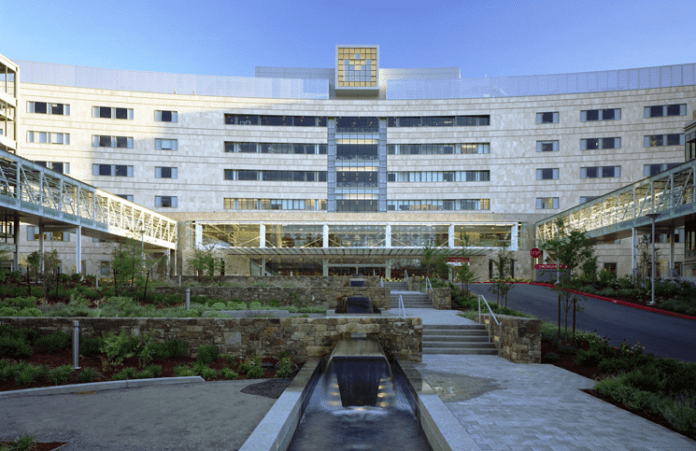“I’ve worked around the country and [Legacy] Salmon Creek is just very different than any place I’ve ever worked,” said Cheryl Forry, nurse manager of intensive care, who was part of the hospital’s opening in 2005.
Legacy Salmon Creek Medical Center commemorates a decade of service this month. One of six hospitals in the 25-year-old Legacy system, Salmon Creek has continually been named one of America’s most beautiful hospitals and has seen tremendous growth and patient satisfaction all around.
“We identified, ten years ago, that there was a healthcare need in the Southwest Washington area and our services have grown with the community,” said Chief Administrative Officer Bryce Helgerson, also with Salmon Creek since 2005. “We started as a general hospital and [our care] is becoming more specified as the needs of the community become more apparent to us.”
Growing specialties include labor and delivery, intensive and intermediate care units, and more recently, cancer services. Salmon Creek also established a Child Abuse Assessment Team, which provides medical exams for child victims of sexual and physical abuse and neglect. Additionally, the hospital is a Certified Primary Stroke Center and its Total Joint Center is among the first in the nation to be certified in all three areas – knee, hip and shoulder.
A number of services provided by Salmon Creek have more than doubled since opening, making it among the busiest of the Legacy hospitals. In 2005, Salmon Creek performed nine surgeries during its first month; now, that number is closer to 500. It is on track to deliver nearly 3,500 babies, and treat more than 70,000 people in its emergency room this year.
According to Forry, despite the rapid growth, one thing that hasn’t changed is the pervasive ‘can-do’ attitude.
“When we first opened, the people that started here used to say you have to have a pioneer spirit,” remembered Forry. She described missing toilet paper and running out of coffee. “You had to be really flexible and have a good sense of humor.”
The entrepreneurial mindset has become ingrained in the hospital culture, from nurses to staff and leadership.
“Here, people just get in a room and start out with: ‘Okay, how do we fix this and what are we going to do?’ and they go forward and do it,” she said, which she noted was markedly different than other places she has worked around the country.
According to Forry, this approach has enabled the hospital to excel at personalized patient care. The team has been known to throw an impromptu prom or wedding if circumstances warrant it.
Contributing to the community is an important Salmon Creek value too. The hospital is one of the area’s largest employers and has provided nearly $24 million to support local safety-net clinics, nonprofits, education and business organizations. Plus, it has performed nearly $300 million in charity care, for people who are unable to pay for their treatment.
“I’ve been [the chief administrative officer] for a year and a half and I’ve been overwhelmed by the number of letters I’ve received from grateful patients,” Helgerson said.
Growth has been a near constant for Salmon Creek. The hospital initially had a vacant sixth floor slated for use within five or 10 years, but it was brought online in 2009 due to quickly increasing need. The $20 million build-out created four new 16-bed units dedicated to neuroscience and total joint replacement.
Another significant growth year was 2013, when Kaiser Permanente selected Salmon Creek as its new partner hospital for 100,000 Clark County members. That resulted in hiring 200 new employees and $7 million in upgrades to add new patient rooms to the Family Birth Center and a unit for step-down care from the Intensive Care Unit.
With no sign of slowing, Salmon Creek will build out its final two operating rooms and add interventional cardiology services in the near future. Finding a balance between expansion and how to best serve the community’s needs is first and foremost on the agenda for the next ten years.
“The focus that we are embarking on now is to really shift healthcare in general,” said Forry. “Instead of having high hospital volumes, [we are shifting] to really try to promote patient health and keep people healthy in the community.”
This month, Legacy Salmon Creek will partner with GoHealth to open the first of several urgent care clinics in Clark County. The clinics will be open on weekends and outside work hours in an attempt to alleviate overloaded emergency rooms and lessen treatment costs.
“The challenge in healthcare is providing care at the appropriate level of where the patient needs it,” said Brian Willoughby, Salmon Creek’s PR & community relations specialist. “That might not even be in urgent care. That might be in their school, in their community and focusing more on health rather than acute healthcare.”
Nationwide, there has been a shortage of primary care doctors for many years. In direct response, Legacy Salmon Creek plans to ramp up its primary care services and a program called Heath Literacy, which is aimed to empower people to take better care of themselves by ensuring patients understand their short and long-term conditions, and by using less technical language in post-visit literature.
“If [patients] leave and they don’t understand what they need to do, we haven’t done any good,” said Willoughby. “Keeping people healthy at home is going to be a vital part of the next ten years.”




